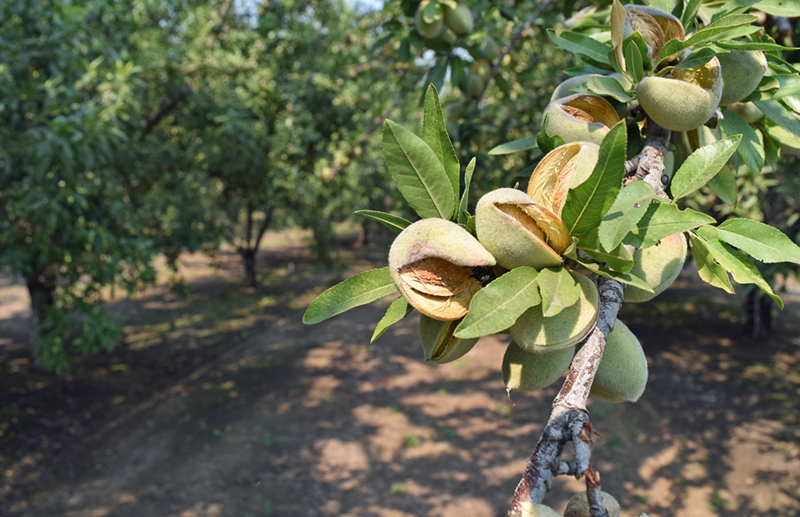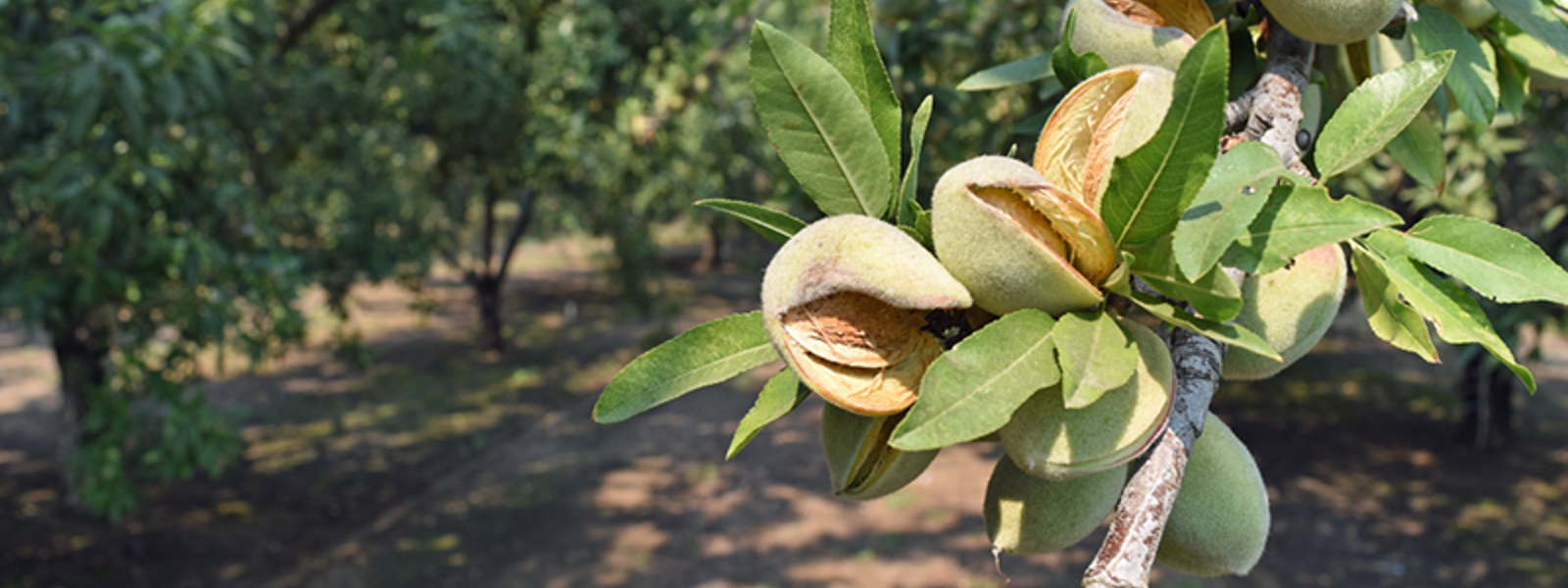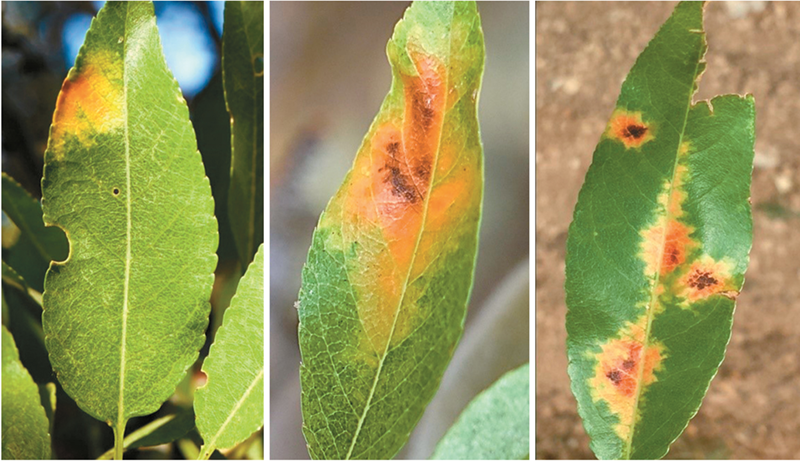First finding of red leaf blotch in California almonds

Almond hulls split in a healthy orchard in Ripon. Researchers, growers and pest control advisors are on the watch for red leaf blotch disease after its recent discovery in some California almond orchards.
Photo/Vicky Boyd


Photos/Alejandro Hernandez and Florent Trouillas
By Vicky Boyd
University of California plant pathologists have confirmed red leaf blotch disease in almonds for the first time in the state, prompting calls for farmers and pest control advisors to keep their eyes peeled.
“The first step is to reach out to UC Extension so the disease can be confirmed—that’s the most important step,” said Florent Trouillas, UC Cooperative Extension fruit and nut crop pathology specialist. “From the disease management perspective for this year, it’s too late. No fungicide is effective once the symptoms are visible, so the whole management strategy needs to be initiated next year in the spring.”
Contacting UCCE farm advisors about suspicious leaf spots also will help the almond industry understand how widespread the fungal disease is, he said. In addition, the information will assist the California Department of Food and Agriculture determine a specific pest rating.
Because of red leaf blotch’s prevalence, Trouillas said it’s likely here to stay.
The disease first surfaced in California in May when UC orchard crops advisor Cameron Zuber contacted Trouillas about unusual leaf symptoms in an almond orchard straddling the Merced-Madera county line. Infected leaves on the nonpareil, Monterey and Fritz varieties had yellow spots with orange to dark red-brown centers.
Zuber said a consultant had texted him photos of unknown leaf symptoms on May 29.
“When I first saw it, I was a little concerned,” he said. “It’s very odd to get this large a lesion that goes across the leaf area. I’m not a plant pathologist, but it looked a little off to me, especially with the color.”
He contacted Trouillas and followed up with the consultant to visit the orchard for a closer look.
Trouillas’ team also collected samples, which were confirmed as red leaf blotch by his lab, CDFA and the U.S. Department of Agriculture.
Zuber said he has since visited a few other orchards in Merced County that had suspicious yellow and orange spots, but they have not yet been confirmed as red leaf blotch.
In the original orchard, he said he didn’t see any defoliation. In subsequent ones, Zuber said he saw some but not widespread defoliation caused by what he assumed was red leaf blotch.
As word of the disease spread and telltale reddish-brown leaf spots became more advanced in June and July, northern San Joaquin Valley farm advisors began to receive an uptick in calls about suspicious leaf spots.
So far, the disease has been found in Madera, Merced, San Joaquin and Stanislaus counties, suggesting it is “somewhat widespread” in the northern San Joaquin Valley, Trouillas said. Suspicious symptoms also have been found but not yet confirmed in a Fresno County orchard.
Red leaf blotch is widespread throughout Europe’s Mediterranean basin and the Middle East and is considered one of the most important foliar almond diseases. It has not been found in Central or South America or Australia.
Trouillas said the disease likely entered California on imported plant material, as that is a common pathway for invasive species and diseases. Based on when symptoms were discovered, he said the disease probably was introduced recently.
Known scientifically as Polystigma amygdalinum, the causative fungus is specific to almonds and does not infect related species such as peaches, nectarines and plums, he said.
The organism overwinters in fallen leaf litter, and during spring rains, it releases ascospores, specialized spores that infect newly emerged leaflets.
The infection remains asymptomatic or latent for 35 to 40 days—about late April to mid-May—after which small, yellow splotches begin to form on each side of the leaf. During this early stage, it could be confused with other common almond problems such as herbicide injury.
As spring progresses, the blotches typically expand and turn orange to reddish-brown.
“When you see them, they’re really bright orange-colored spots and blotches on leaves,” Trouillas said. “It’s really unique and cannot be confused with anything else.”
A severe infection may cause premature leaf loss, according to reports from Spain.
In addition, the disease is weather-dependent, Trouillas said. Rain coupled with mild spring temperatures are conducive to disease development, while leaf infection drastically decreases with high summertime temperatures and low humidity.
The good news is many of the same fungicides used to manage spring almond diseases such as anthracnose and shot hole also appear effective against red leaf blotch, Trouillas said, citing studies conducted in Spain. Research from that country also found one fungicide application at petal fall followed by two additional ones at two and five weeks after petal fall, if rains continue, were effective at controlling red leaf blotch.
The sprays must be applied as a preventive treatment and aren’t effective once symptoms are present, he said.
Trouillas and his colleagues plan to conduct field trials next spring to determine fungicide efficacy under California conditions. They also plan to work with chemical manufacturers to add red leaf blotch to fungicide labels so growers can use them to manage the disease.
Since red leaf blotch has only one infection cycle per season, researchers in Spain have looked at reducing the primary source of overwintering inoculum by removing leaf litter, spraying fallen leaves with fungicides or applying urea to speed decomposition. To be effective, Trouillas said those practices should be done on an area-wide basis and would be difficult to implement in California.
(Vicky Boyd is a reporter in Modesto. She may be contacted at vlboyd@att.net.)




